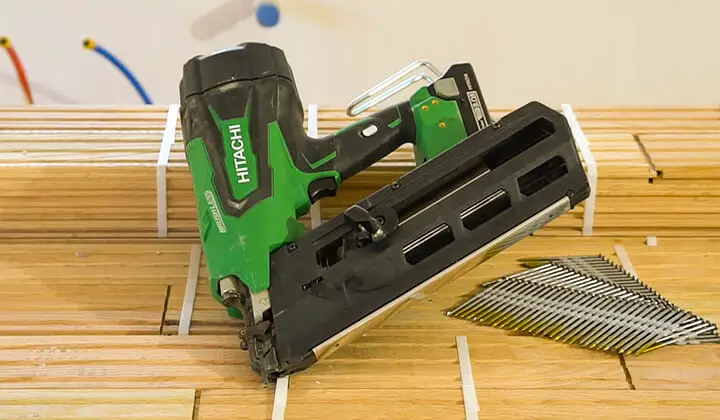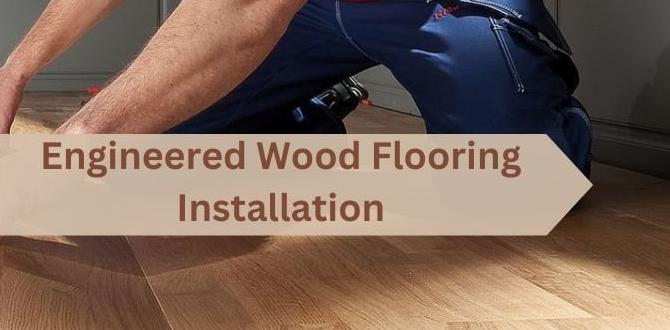Looking for the best budget cordless nailer for your DIY projects? Unlock professional results without breaking the bank! Discover top picks for reliable, affordable cordless brad nailers that make home repairs and creative builds easier than ever. Perfect for beginners and seasoned DIYers alike, these tools offer power, convenience, and value, empowering your next project.
Hey there, DIY fans! Jack from Nailerguy here. Ever found yourself wrestling with a hammer and nails, wishing there was a faster, tidier way to get those projects done? You’re not alone! For many of us, the thought of using a nail gun can be a bit intimidating, or maybe the price tags seem way too high for a hobbyist. But imagine finishing that trim, building that shelf, or even tackling furniture restoration with straight, clean nails, every single time. It’s totally achievable, even on a budget!
The good news is, you don’t need to be a professional carpenter with a hefty tool budget to enjoy the benefits of a cordless nailer. These amazing tools have become incredibly accessible, offering a fantastic blend of power, portability, and ease of use. We’re going to cut through the confusion and find you a fantastic budget-friendly option that will make your DIY life so much simpler. Ready to build with confidence? Let’s dive in!
Table of Contents
Why a Cordless Nailer is a DIY Game-Changer
If you’ve ever tackled a project involving attaching wood, you know the struggle. Hammers can leave dents, nails can bend, and keeping everything perfectly straight can be a real challenge, especially when you’re working alone. This is where a nailer, particularly a cordless one, truly shines.
A cordless nailer uses a battery and a high-pressure air system (or sometimes a gas cartridge and battery combination) to drive nails quickly and precisely. Unlike their corded or pneumatic (air hose) cousins, they offer freedom of movement. No tangled cords to trip over, no air compressor to lug around, and no noisy exhaust. This makes them perfect for working in tight spaces, working at heights, or simply moving around your project with ease. They significantly speed up tasks like:
- Installing trim (baseboards, crown molding, window/door casings).
- Building simple furniture or shelving units.
- Repairing fences or outdoor furniture.
- Upholstery projects (with smaller gauge nails).
- Quick repairs around the house.
For the DIYer, the convenience and the professional finish a nailer provides are invaluable. It’s an investment that pays off in saved time, reduced frustration, and a much better-looking final product.
Understanding Cordless Nailer Types for Budget DIY
When we talk about cordless nailers for DIY, we’re usually focusing on a few key types, each suited for different tasks. For budget-conscious beginners, the most common and versatile options are:
1. Cordless Brad Nailers
Brad nailers use thin, small-headed nails (think 18-gauge or 16-gauge). They’re ideal for delicate work where you want minimal visible damage.
- Perfect for: Attaching thin trim, delicate moldings, small boxes, cabinet assembly, and even upholstery.
- Pros: Leaves very small holes that are easy to fill, lightweight, generally more affordable for the tool itself.
- Cons: Not strong enough for structural connections.
When searching for the “best budget cordless brad nailer for DIY,” this is likely what you’ll find most recommendations for, and for good reason. They’re the workhorses for cosmetic and light construction tasks.
2. Cordless Finish Nailers
Finish nailers use slightly thicker nails (often 15-gauge or 14-gauge) with a more substantial head than brad nails. They offer a bit more holding power.
- Perfect for: Installing sturdier trim, attaching door jambs, window frames, and some lighter cabinetry.
- Pros: Good balance of holding power and minimal visibility.
- Cons: Holes are slightly larger than brad nails.
3. Cordless Pin Nailers
These use extremely thin, headless pins (23-gauge). They’re almost invisible once driven.
- Perfect for: Very fine detail work, holding small pieces in place while glue dries, delicate craft projects.
- Pros: Virtually invisible nail holes.
- Cons: No holding power; purely for alignment or decorative purposes.
4. Cordless Framing Nailers
These use much larger, stronger nails (like 2x4s) for structural building.
- Perfect for: Building decks, framing walls, subflooring.
- Pros: Incredible power for heavy-duty construction.
- Cons: Much larger, heavier, and significantly more expensive. Overkill for most typical home DIY projects.
For most beginners focused on home improvement and smaller woodworking projects, a cordless brad nailer is the sweet spot for budget and versatility. It’s the tool that will get the most use without requiring a huge initial investment.
Key Features to Look for in a Budget Cordless Nailer
When you’re on the hunt for a great deal, it’s easy to get overwhelmed by specs. Here’s a breakdown of what really matters for a budget-friendly, reliable cordless nailer:
- Battery Platform: Many brands offer tools on the same battery system. If you already own a drill from a particular brand (like Ryobi, DeWalt, Makita, etc.), buying another tool from that brand may mean you can use your existing batteries and charger. This is a huge cost saver!
- Gauge Size: As discussed, an 18-gauge brad nailer is the most versatile for DIY trim and craft work. A 16-gauge finish nailer is a good second choice if you need a bit more holding power for slightly larger trim.
- Depth Adjustment: This is crucial. It allows you to control how deep the nail drives into the wood. Too shallow, and it won’t hold. Too deep, and you’ll punch through delicate material or create a divot. A tool-free or easily accessible depth adjustment is a big plus.
- Nail Jam Clear (Tool-Free): Jams happen, especially with any nailer. Being able to clear a jammed nail quickly and without needing extra tools (like an Allen wrench) makes a huge difference in workflow and frustration levels.
- Dry Fire Lockout: This feature prevents the nailer from firing when the magazine is empty. It protects the tool and your workpiece from accidental, forceful impacts.
- Weight and Ergonomics: Even budget tools should feel comfortable in your hand. A tool that’s too heavy or awkward will fatigue you quickly, especially if you’re working overhead or for extended periods. Look for padded grips and good balance.
- Magazine Capacity: How many nails can the magazine hold? More nails mean less reloading, which speeds up projects. For most DIYers, a capacity of 100-150 nails is generally good.
- Number of Batteries Included: Some budget kits come with only one battery. If you plan for longer work sessions or don’t want to wait for a battery to recharge, consider a kit that includes two batteries or a brand with readily available, affordable extra batteries.
Don’t be afraid of lesser-known brands if they have good reviews, decent warranties, and are built on a compatible battery platform you already own. Often, these offer excellent value.
Top Budget Cordless Nailer Picks for DIYers
Finding the “best budget cordless brad nailer for DIY” requires balancing cost, features, and reliability. While prices fluctuate and models update, here are categories and brands typically known for offering great value in the starter to mid-range cordless nailer market. It’s always wise to read recent user reviews before purchasing!
| Category/Brand Example | Typical Gauge | Key Strengths for Budget DIYers | Potential Drawbacks |
|---|---|---|---|
| Ryobi ONE+ (18V) | 18 Ga. Brad, 16 Ga. Finish | Excellent battery platform integration, widely available, often bundled for great value, tool-free jam release. | Pro-level power might be slightly less than premium brands. |
| Craftsman V20 | 18 Ga. Brad | Affordable kits, decent performance for the price, part of a growing cordless system. | Durability over the long haul can sometimes be a question compared to higher tiers. |
| WEN 20-Volt MAX | 18 Ga. Brad | Extremely competitive pricing, often includes batteries and charger, surprising performance for the cost. | Brand recognition is lower, battery longevity might not match leading brands. |
| Porter-Cable 20V MAX | 18 Ga. Brad, 16 Ga. Finish | Solid mid-range option that balances price and performance, reliable for DIY tasks, often found on sale. | Battery costs can add up if you don’t catch a good kit deal. |
| Kobalt (Lowes House Brand) | 18 Ga. Brad, 16 Ga. Finish | Good value, especially during sales events at Lowes, decent performance for home use. | Availability is limited to Lowes stores. |
When looking for deals, always check major retailers like Amazon, Home Depot, Lowe’s, and manufacturer websites. Bundle deals (tool + battery + charger) are almost always the best way to go for budget buyers.
How to Use Your New Cordless Nailer Safely
Safety is paramount. Nail guns are powerful tools, and using them improperly can lead to serious injury. Always read your manufacturer’s manual. Here are the core safety principles:
- Read the Manual: Seriously, this is the first step! Every nailer is slightly different, and the manual has crucial safety and operational information specific to your tool.
- Wear Safety Glasses: Always. Always. Always. Even when just loading nails. Flying debris is a real hazard. Consider a full face shield for added protection.
- Never Point at Anyone: Treat it like a firearm. Never point the tool at yourself or anyone else, even with the safety engaged.
- Keep Fingers Away from Trigger and Tip: Don’t put your finger on the trigger unless you are actively firing. Keep fingers clear of the firing nose and magazine.
- Engage Safety Tip/Contact Nose: Most nailers have a safety mechanism on the tip (the contact nose) that must be pressed against the workpiece before the trigger will fire. Always ensure this is engaged correctly.
- Never “Dry Fire” Intentionally: While some models have dry fire lockout, don’t intentionally pull the trigger without a nail. This can damage the tool and your workpiece.
- Secure Your Workpiece: Make sure the material you are nailing into is stable. Use clamps if necessary, especially for smaller pieces.
- Be Aware of Your Surroundings: Ensure no one is behind your workpiece where a nail could pass through.
- Disconnect Battery When Not in Use or Clearing Jams: Always remove the battery when storing the tool, performing maintenance, or clearing a jam to prevent accidental firing.
Here’s a helpful graphic from the Occupational Safety and Health Administration (OSHA) on nail gun safety, full of great tips for any user:
[Placeholder for an img tag if embedding a graphic, or a descriptive paragraph pointing to the external link]
A little bit of caution goes a long way in preventing accidents and ensuring you can enjoy your DIY projects safely.
Step-by-Step: Getting Started with Your Cordless Brad Nailer
Ready to put your new tool to work? Here’s a simple guide to get you started:
Step 1: Prepare Your Workspace and Materials
- Ensure good lighting and ventilation.
- Clear the area of clutter and trip hazards.
- Have your wood pieces ready, clean, and dry.
- Gather any necessary clamps, measuring tools, and safety gear (especially eye protection!).
- If you’re installing trim, have it cut to size.
Step 2: Inspect Your Nailer
- Wipe down the tool to make sure it’s clean.
- Check that the magazine latch is secure.
- Ensure the depth adjustment is set to a reasonable starting point (you’ll fine-tune this).
Step 3: Load the Nails
- Remove the battery from the nailer.
- Slide the magazine adjustment lever (usually at the front of the magazine) to extend the spring.
- Place the correct gauge and length of nails into the magazine. Make sure they are straight and properly seated. Common lengths for 18-gauge brad nailers for trim are 1-1/4 inch to 2 inches.
- Gently release the spring tension. The follower arm should hold the nails snugly.
- Re-insert the battery.
Pro Tip: Always use the nail size recommended for your project. Using nails that are too short won’t hold well; nails that are too long can go too deep and damage underlying material or even pass through.
Step 4: Set the Depth Adjustment
This is where you fine-tune for your specific wood and nail size.
- Place the nailer on a scrap piece of the same wood you’ll be working on.
- Bring the contact nose flush against the wood.
- Squeeze the trigger.
- Check the nail depth.
- If the nail head is sticking out, increase the depth (often by turning a dial clockwise, but check your manual).
- If the nail head is sinking too deep, decreasing the depth (counter-clockwise).
- Repeat until the nail head is just slightly below the surface of the wood, leaving a small, easily filled dimple.
Step 5: Nailing Technique
- Position the nose of the nailer firmly against the wood where you want the nail.
- Ensure the safety contact tip is pressed flat against the surface.
- Squeeze the trigger smoothly.
- For sequential firing (most common for precise placement), pull the trigger and then press the contact nose to the surface.
- For rapid firing (bump firing, use with extreme caution and only if your tool has this mode and you are experienced), hold the trigger down and “bump” the contact nose against the surface. This is faster but less precise and can be more dangerous. Beginners should stick to sequential firing.
- Hold the nailer firmly against the wood for a second after firing to ensure the nail is fully driven.
Take your time, especially on your first few projects. You’ll quickly develop a feel for it. Remember to wear your safety glasses throughout!
Troubleshooting Common Nailer Issues
Even the best tools can have hiccups. Here are a few common issues and how to solve them:
- Nail Jams: This is the most frequent issue.
- First, remove the battery. Never attempt to clear a jam with the battery connected.
- Look for the jam access panel (usually on the side or front of the magazine).
- Use a flathead screwdriver or the tool’s provided Allen wrench (though tool-free is better!) to carefully dislodge the jammed nail.
- Once clear, reassemble, reconnect the battery, and test with a scrap piece.
- Nails Not Driving Fully:
- Check your depth adjustment. It might be set too shallow.
- Ensure you’re using the correct nail length for the wood thickness.
- Is the battery low? A weak battery can reduce driving power.
- Are you pressing the contact nose firmly enough against the wood?
- Is the nailer magazine empty? Some tools won’t drive if the battery is low and can’t push a nail with sufficient force.
- Tool Firing Randomly:
- Is the safety lock engaged?
- Is your finger on the trigger when it shouldn’t be?
- Check for any damage to the trigger mechanism or safety contact nose. Consult your manual or customer support.
- Air Leaks or Weak Firing (less common on battery models, but can occur if seals are damaged):
- Inspect seals around
- Inspect seals around





